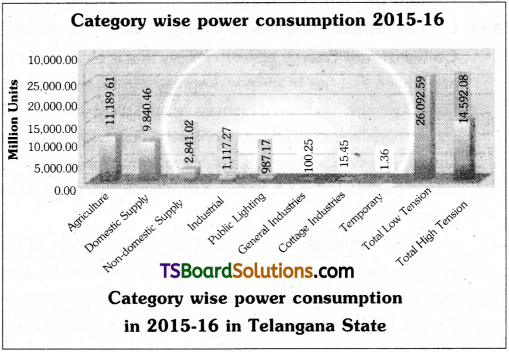Telangana TSBIE TS Inter 1st Year Environmental Education Study Material 10th Lesson Demand for Energy and Energy Consumption Patterns Textbook Questions and Answers.
TS Inter 1st Year Environmental Education Study Material 10th Lesson Demand for Energy and Energy Consumption Patterns
Essay Questions
Question 1.
Write an essay on energy consumption.
Answer:
Energy is defined as power derived from the utilization of physical or chemical resources, especially to provide light and heat or to work machines. The amount of energy consumed in a process or system, or by an organization or society is known as Energy Consumption. Energy consumption can be classified under four economic sectors: Residential, Commercial, Transportation and Industrial.
Energy Consumption Sectors :
- Residential sector energy is the energy used for domestic purposes. Examples are the use of charcoal, wood, kerosene and LPG for cooking, use of electricity and batteries to run devices such as fans, lights, generators, T.Vs, refrigerators, coolers and computers.
- Commercial sector energy is the energy used in businesses and organizations. It also includes energy used by municipalities for street lighting, disposal of garbage and supply of water.
- Transportation sector energy consumption is the energy consumed, mostly as petrol and diesel, by various modes of transport which are used to carry passengers or move goods. Cars, buses, trucks, aeroplanes and ships are the most common modes of transport.
- Industrial sector energy includes manufacturing, agriculture, construction, forestry and mining. Energy is used in industries for various purposes, such as to produce heat and steam in industrial processes, in brick kilns, to run machinery and for drilling. Every industry uses energy but the maxi-mum energy is consumed by the bulk chemicals industry, the refining industry and mining.
Global Energy Consumption is the total energy used by the entire human civilization at any given point of time. The consumption of energy worldwide has dramatically increased over the last few decades. Since 1800 it has increased by more than 25 times. It is closely associated with two factors :
a) Growth in Population :
As the population of the world increases, so do energy needs. Food production must keep pace with the burgeoning population. More houses, schools and hospitals need to be built. Adequate infrastructure like roads, sewerage and garbage disposal systems must be provided. Large amounts of energy are expended for all these activities.
b) Growth in Per Capita Income :
As standards of living improve, so does energy consumption. If a person’s income increases, he is likely to stop using public transport and will buy his own car. He may now live in a bigger house and buy several kinds of goods and gadgets to keep himself comfortable. His energy consumption, thus, increases.
![]()
Energy Scenario in the Future :
Based on current trends of energy consumption, scientists have made predictions about the likely scenario in the future. Some of the observations and predictions made by them are :
- Fast growth in developing economies will drive up global energy demand multifold.
- According to some estimates, the global energy mix basket will be much bigger by 2040 with oil, gas, coal and non-fossil fuels each contributing around a quarter.
- Renewable sources of energy are growing very fast, increasing five-fold and providing around 14% of primary energy.
- With ever-growing population, the demand for oil and natural gas is increasing. Efforts are being made worldwide to scale up the exploitation of the existing reserves.
- Oil and gas together account for over half of the world’s energy.
- Global coal consumption, however, is not increasing and it seems likely that Chinese coal consumption has plateaued.
- The number of electric cars will grow to around 15% of the total number of cars, but because of the much higher intensity with which they are used, they will account for 30% of passenger vehicle kilometers.
- Carbon emissions will continue to rise, signalling the need for a comprehensive set of actions to stem the damage to the environment.
- All of the growth in energy consumption is happening in the fastest emerging economies : China and India.
• Renewable energy is the fastest-growing energy source, accounting for 40% of the increase in primary energy.
Demand for oil and other liquid fuels will grow for some years but will gradually slow down and stabilize by the 2030s. - The availability of Liquified Natural Gas (LNG) will increase globally.
Energy Consumption in India :
Energy consumption is greatly increasing in developing countries like India which are experiencing good economic growth. India’s energy consumption is set to grow 4.2% a year by 2035, faster than that of all major economies in the world. India is Asia’s second biggest energy consumer since 2008. In 2015 it overtook Japan as the world’s third largest oil consuming country, after the U.S.A and China. India’s consumption growth of fossil fuels will be the highest by 2035 and it will overtake China as the largest growth market.
